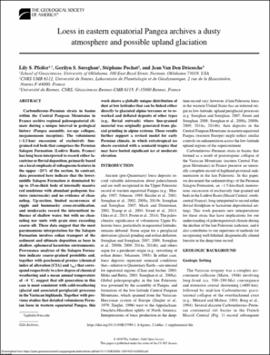| dc.contributor.author | Pfeifer, Lily S. | |
| dc.contributor.author | Soreghan, Gerilyn S. | |
| dc.contributor.author | Pochat, Stéphane | |
| dc.contributor.author | Van Den Driessche, Jean | |
| dc.date.accessioned | 2020-08-26T14:38:01Z | |
| dc.date.available | 2020-08-26T14:38:01Z | |
| dc.date.issued | 2020-06-19 | |
| dc.identifier.citation | Pfeifer, L., Soreghan, G., Pochat, S., Van Den Driessche, J. (2020). Loess in eastern equatorial Pangea archives a dusty atmosphere and possible upland glaciation. GSA Bulletin 132(7-8). doi:10.1130/B35590.1 | en_US |
| dc.identifier.uri | https://hdl.handle.net/11244/325416 | |
| dc.description.abstract | Carboniferous−Permian strata in basins within the Central Pangean Mountains in France archive regional paleoequatorial climate during a unique interval in geological history (Pangea assembly, ice-age collapse, megamonsoon inception). The voluminous (∼1.5 km) succession of exclusively fine-grained red beds that comprises the Permian Salagou Formation (Lodève Basin, France) has long been interpreted to record either lacustrine or fluvial deposition, primarily based on a local emphasis of subaqueous features in the upper ∼25% of the section. In contrast, data presented here indicate that the lower-middle Salagou Formation is dominated by up to 15-m-thick beds of internally massive red mudstone with abundant pedogenic features (microscale) and no evidence of channeling. Up-section, limited occurrences of ripple and hummocky cross-stratification, and mudcracks record the intermittent influence of shallow water, but with no channeling nor units with grain sizes exceeding coarse silt. These data suggest that the most parsimonious interpretation for the Salagou Formation involves eolian transport of the sediment and ultimate deposition as loess in shallow, ephemeral lacustrine environments. Provenance analyses of the Salagou Formation indicate coarse-grained protoliths and, together with geochemical proxies (chemical index of alteration [CIA] and τNa) that correspond respectively to a low degree of chemical weathering and a mean annual temperature of ∼4 °C, suggest that silt generation in this case is most consistent with cold-weathering (glacial and associated periglacial) processes in the Variscan highlands. Together with previous studies that detailed voluminous Permian loess in western equatorial Pangea, this work shows a globally unique distribution of dust at low latitudes that can be linked either directly to glaciated alpine terranes or to reworked and deflated deposits of other types (e.g., fluvial outwash) where fine-grained material was originally generated from glacial grinding in alpine systems. These results further support a revised model for early Permian climate, in which extratropical ice sheets coexisted with a semiarid tropics that may have hosted significant ice at moderate elevation. | en_US |
| dc.description.sponsorship | This work was supported by the National Science Foundation (NSF) under International Research Ex-periences for Students (IRES) grant OISE-1658614 (principal investigators G.S. Soreghan, M.J. Soreghan) and also EAR-1338331 (Sedimentary Geology and Paleobiology Program; to G.S. Soreghan). Financial support for partially offsetting publication costs was provided from the Office of the Vice President for Research and the Office of the Provost, University of Oklahoma. | en_US |
| dc.language | en | en_US |
| dc.rights | Attribution 4.0 International | * |
| dc.rights.uri | https://creativecommons.org/licenses/by/4.0/ | * |
| dc.subject | Loess | en_US |
| dc.subject | Geology | en_US |
| dc.subject | Pangea | en_US |
| dc.subject | Glaciation | en_US |
| dc.subject | Carboniferous−Permian | en_US |
| dc.subject | France | en_US |
| dc.title | Loess in eastern equatorial Pangea archives a dusty atmosphere and possible upland glaciation | en_US |
| dc.type | Article | en_US |
| dc.identifier.doi | https://doi.org/10.1130/B35590.1 | en_US |
| ou.group | Mewbourne College of Earth and Energy::School of Geosciences | en_US |

